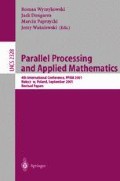Abstract
In this paper we report new results concerning using cellular automata (CAs) to perform distributed scheduling tasks of a parallel program in the two processor system. We consider a program graph as a CA with elementary cells interacting locally according to a certain rule. The purpose of the cell’s interaction is to find an optimal tasks’ allocation starting from any initial tasks’ allocation. Searching effective rules is conducted with use of a genetic algorithm (GA). The main aim of this work is to study the possibility of reusing discovered scheduling rules. We propose to use the immune-like system approach to answer this question.
Access this chapter
Tax calculation will be finalised at checkout
Purchases are for personal use only
Preview
Unable to display preview. Download preview PDF.
References
R. Das, M. Mitchell and J. P. Crutchfield, A genetic algorithm discovers particle-based computation in cellular automata, in Davidor, Y., Schwefel, H.-P., Männer, R. (Eds.), Parallel Problem Solving from Nature-PPSN III, LNCS 866, Springer, 1994, pp. 344–353
J. D. Farmer, N. H. Packard, A. S. Perelson, The immune system, adaptation, and machine learning, Physica D, 22, 1986, pp. 187–204
S. Forrest, B. Javornik, R. Smith, A. S. Perelson, Using genetic algorithms to explore pattern recognition in the immune system, Evolutionary Computation, 1, 1993, 191–211
M.R. Gary and D.S. Johnson, Computers and Intractability: A Guide to the Theory of NP-Completeness, W.H. Freeman and Company, 1979
Y.K. Kwok and I. Ahmad, Benchmarking the Task Graph Scheduling Algorithms, in Proceedings of 1998 IPPS/SPDP Symposium, Orlando, Florida, 1998, pp. 531–537
Z. Michalewicz, Genetic Algorithms + Data Structures = Evolution Programs, Springer, 1992
A. S. Perelson, Immune network theory, Immunological Review, 110, 1989, pp. 5–36
S. Saleh and A.Y. Zomaya, Multiprocessor Scheduling Using Mean-Field Annealing, in Parallel and Distributed Processing, LNCS 1388, Springer, pp. 288–296
F. Seredynski, Scheduling Tasks of a Parallel Program in Two-Processor Systems with use of Cellular Automata, Future Generation Computer Systems 14, Elsevier, 1998, pp. 351–364
M. Sipper, Evolution of Parallel Cellular Machines. The Cellular Programming Approach, LNCS 1194, Springer, 1997
A. Święcicka, F. Seredyński, Cellular Automata Approach to Scheduling Problem, in Proceedings of International Conference on Parallel Computing in Electrical Engineering: PARELEC 2000, 27–30 August, 2000, Trois-Rivieéres, Québec, Canada, IEEE Computer Society, pp. 29–33
L. Wang, H.J. Siegel, V.P. Roychowolhury, and A.A. Maciejewski, Task Matching and Scheduling in Heterogeneous Computing Environments Using a Genetic-Algorithm-Based Approach, in J. of Parallel and Distributed Computing 47, 1997, pp. 8–22
S. Wolfram, Universality and complexity in cellular automata, in Physica D, 10, 1984, pp. 1–35
Author information
Authors and Affiliations
Editor information
Editors and Affiliations
Rights and permissions
Copyright information
© 2002 Springer-Verlag Berlin Heidelberg
About this paper
Cite this paper
Seredyński, F., Świeęcicka, A. (2002). Immune-Like System Approach to Cellular Automata-Based Scheduling. In: Wyrzykowski, R., Dongarra, J., Paprzycki, M., Waśniewski, J. (eds) Parallel Processing and Applied Mathematics. PPAM 2001. Lecture Notes in Computer Science, vol 2328. Springer, Berlin, Heidelberg. https://doi.org/10.1007/3-540-48086-2_69
Download citation
DOI: https://doi.org/10.1007/3-540-48086-2_69
Published:
Publisher Name: Springer, Berlin, Heidelberg
Print ISBN: 978-3-540-43792-5
Online ISBN: 978-3-540-48086-0
eBook Packages: Springer Book Archive

